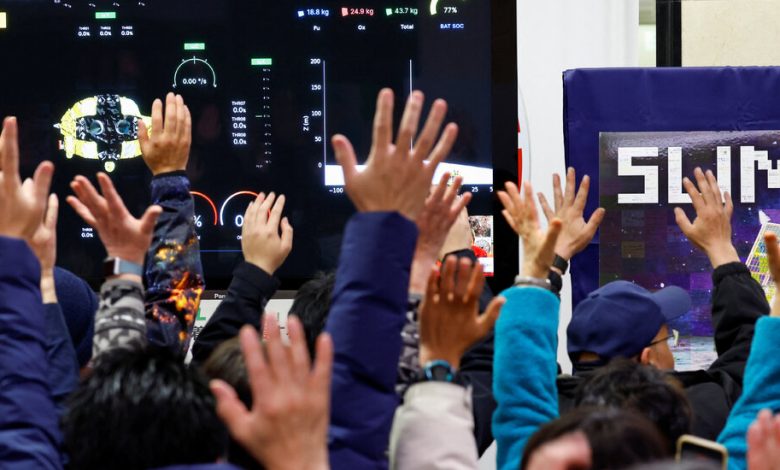Japan Becomes the Latest Country to Land on the Moon

A Japanese robotic spacecraft successfully set down on the moon on Friday — but its solar panels were not generating power, which will cut the length of time it will be able to operate to a few hours.
With this achievement, Japan is now the fifth country to send a spacecraft that made a soft landing on the moon.
For JAXA, Japan’s space agency which currently operates a variety of robotic science missions in space, this was the first time it had tried to set down on a planetary body elsewhere in the solar system. The spacecraft, the Smart Lander for Investigating Moon, or SLIM, was intended to demonstrate precision landing, within a football field of a targeted destination rather than an uncertainty of miles that most landers are capable of.
The technology could also be useful for future missions like those in NASA’s Artemis program . Japan is a partner in that program, which will send astronauts back to the moon in the coming years.
At 10 a.m. Eastern time on Friday — midnight in Japan, the beginning of Saturday — SLIM fired its engines to begin its descent from lunar orbit. At 10:20, its main landing gear touched the surface near a small crater named Shioli in the equatorial region of the moon’s near side.
The surface there is angled about 15 degrees, which posed difficulties for landing without tipping over. The designers of SLIM thus decided to tilt the spacecraft to one side just before landing, and then after the initial contact with the ground, SLIM tipped forward onto its front legs.
Immediately after the landing, SLIM was able to send radio signals back to Earth. But the commentator on the webcast at that time said repeatedly, “We are still checking the status.” The webcast ended without disclosing SLIM’s fate.
At a news conference a couple of hours later, JAXA officials said the soft landing succeeded but revealed the solar panel problem.
They said it was possible that the panels were just pointing in the wrong direction, and they could generate energy later when the sun was shining at a different angle. The landing satisfied the minimal requirements for mission success, officials said. If the landing occurred within 100 meters of the target, that would constitute full success, although it will take a month of analysis to determine how close SLIM was.
Without working solar panels, the spacecraft is operating using its battery. To conserve energy, the spacecraft’s heaters have been shut off, JAXA officials said.
During the limited time, mission managers were prioritizing the retrieval of navigation data acquired during the landing.
Two small rovers were successfully deployed from the lander just before landing.
Deploying such pinpoint landing capabilities in the future would allow spacecraft to aim closer to intriguing places like craters, instead of large flat plains.
Because the moon has no global positioning satellites or radio beacons, spacecraft have to figure out by themselves exactly where they are. Radar pings informed SLIM how high it was and how fast it was moving. A camera taking pictures of the landscape below helped the spacecraft determine its location by matching the pattern of craters it saw with maps stored in its memory.
Vision-based systems on spacecraft have been limited because they use special computer chips that are hardened against the strong radiation of deep space. Such chips are generally one or two generations behind top-of-the-line chips, with only about one one-hundredth the processing power, JAXA said in a press kit for the SLIM mission.
JAXA developed image-processing algorithms that can run quickly on the slower space chips.
The images allowed SLIM to avoid hazardous rocks and other obstacles during its final approach.
The two rovers deployed by SLIM, called Lunar Excursion Vehicle 1 and Lunar Excursion Vehicle 2, were unconventional. One used a hopping mechanism and carried a thermometer, a radiation monitor and an instrument for measuring the slope and elevation.
The second rover was spherical, about the size of a baseball and weighing a half-pound. Its two halves were to pull apart, allowing the rover to crawl along the surface for a couple of hours until its battery was exhausted. JAXA developed this rover in cooperation with Doshisha University and Tomy, a toy company.
LEV-1 was able to communicate directly with Earth, and LEV-2 communicated via LEV-1. Data from the two rovers was being sent back to Earth, JAXA said.
Even with limited power, an instrument on the lander attempted to analyze the composition of rocks around the lander.
Over the past 11 years, a parade of spacecraft have headed toward the moon. Less than half of them made it to their destination intact.
China is the only country with a perfect record landing its robotic spacecraft on the moon — three successes in three attempts. India succeeded last year after an earlier attempt in 2019 crashed. Other attempts by Russia, a Japanese private company and an Israeli nonprofit all failed.
The latest failure, a spacecraft built by Astrobotic Technology of Pittsburgh, never even made it to the moon because of a malfunction in its propulsion system shortly after reaching orbit.
Other spacecraft will try to reach the moon this year. A second American company, Intuitive Machines of Houston, has a contract to take NASA experiments to the moon. It is aiming to launch its lander as soon as the middle of next month. China may also attempt a robotic landing mission to the lunar far side this year.
Japan has future lunar plans of its own. It is working with India on launching a robotic rover, LUPEX, as soon as next year. Japanese astronauts may head to the moon in the future as part of NASA’s Artemis program.
Hisako Ueno contributed reporting from Tokyo.



